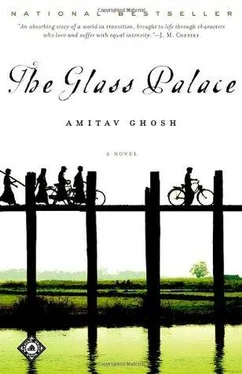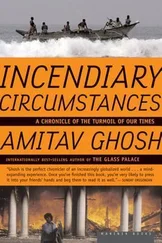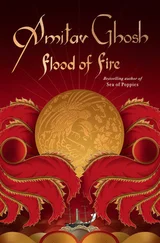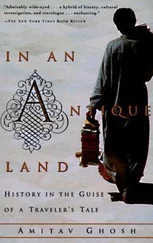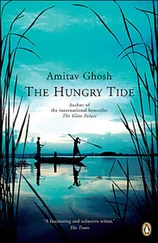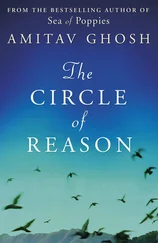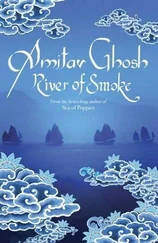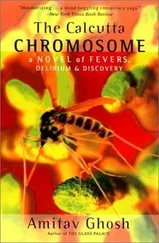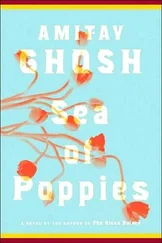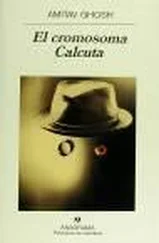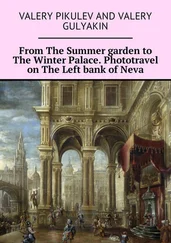Jaya had never met a princess before and didn’t know what to do. But she was not without a certain resourcefulness; she recalled a movie she had recently seen — was it Sleeping Beauty or Cinderella ? — and sketched the beginning of a curtsey, holding the edge of her dress pinched between finger and thumb. She was rewarded with a hug from the Princess.
Later, people gathered around Rajkumar, wondering why she had singled him out. ‘What did Her Highness say?’ they asked. ‘How did she know you?’
‘Oh, I’ve known her most of my life,’ Rajkumar said off-handedly.
‘Really?’
‘Yes. The first time I saw her was in Mandalay and she was just six months old.’
‘Oh? And how did that come about?’
And then Rajkumar would start at the beginning, going back to that day more than sixty years before, when he had heard the sound of English cannon rolling in across the plain to the walls of Mandalay’s fort.

In a quiet corner of Lankasuka, there was a niche that served as a shrine to Jaya’s parents and her uncle, Arjun. Two framed photographs stood in the niche: one of these was a picture of Manju and Neel, taken at their wedding — they’d been caught glancing up from the sacramental fire, in surprise. The hooded veil of Manju’s sari had slipped momentarily from her head. They were smiling, their faces shining and radiant. The photograph of Arjun was taken at Howrah Station: he was in uniform, laughing. A second face was clearly discernible, over his shoulder: Bela told her niece that this was her uncle’s batman, Kishan Singh.
Three times each year, Bela and Jaya would perform a small ceremony at their shrine. They’d garland the photographs and light incense. Bela would hand Jaya flowers, directing her to pay her respects to her mother, her father and Arjun, the uncle she had never known. But when Bela lit the dhoop sticks, there were always four bunches, not three. Without ever being told, Jaya knew that the extra one was for Kishan Singh: he too was among their dead.
It was only when Jaya was ten years old, already conscious of a growing interest in cameras and photographs, that it occurred to her to ask her aunt about the pictures and who had taken them.
Bela was surprised. ‘I thought you knew,’ she said in puzzlement. ‘They were taken by your uncle Dinu.’
‘And who was that?’ said Jaya.
This was how Jaya learnt that she had a second uncle, on her father’s side — an uncle who had not been memorialised because his fate was unknown. In Lankasuka no one ever spoke of Dinu — neither Rajkumar, nor Uma nor Bela. No one knew what had become of him. He was known to have stayed on at Morningside until the last weeks of 1942. At some point after that he’d left for Burma. Nothing had been heard from him since. Privately everyone suspected that he had become yet another casualty of the war, but no one wished to be the first to voice this fear and, as a result, Dinu’s name was never mentioned in the house.
Through the late 1940s, the shadows of the Second World War deepened over Burma. First there were protracted civil conflicts and a large-scale Communist uprising. Then, in 1962, General Ne Win seized power in a coup and the country became subject to the bizarre, maniacal whimsies of its dictator: Burma, ‘the golden’, became synonymous with poverty, tyranny and misgovernment. Dinu was among the many millions who had vanished into the darkness.
Until the day of her marriage Jaya lived in Lankasuka, with Bela, Uma and Rajkumar. She married young, at the age of seventeen. Her husband was a doctor, ten years older. They were very much in love and a year after the wedding, they had a son.
But when the boy was two years old, tragedy struck: his father was killed in a train accident.
Soon after this Jaya moved back to Lankasuka. With her aunt Bela’s support, she enrolled at Calcutta University, took a degree and found a job as a college teacher. She worked hard to give her son a good education. He went to the city’s best schools and colleges and at the age of twenty-two he won a scholarship and went abroad.
Now for the first time in years, Jaya had time on her hands. She resumed work on a long-delayed PhD thesis, on the history of photography in India.

In 1996 Jaya’s college sent her to an art history conference at the University of Goa. On the way, while changing planes at Bombay airport, she was ambushed by one of the worst of all possible airport experiences: on arriving at the check-in counter she was told that her plane had been overbooked. If she wanted to be sure of a seat she would have to wait at least a couple of days; alternatively the airline would pay for a bus or a train.
Jaya went to another counter, brandishing her ticket. She found herself at the end of a long line of angry people; they were all shouting the same refrain at the desk-clerk: ‘But we had reservations. .’
Jaya was slightly built and of medium height. Her hair was wispy and grey and she looked very much what she was — an unassuming and rather withdrawn college professor who often had difficulty keeping order in class. She knew that there was no point in adding her voice to the chorus of indignation at the counter: where the others had been foiled, no one was less likely to prevail than someone such as herself. She decided to take the train.
Bombay was not a city that Jaya knew well. She collected a voucher and went to Shivaji station on a bus provided by the airline. She bought a railway timetable and learnt that the earliest train was not till several hours later. She got her ticket and then decided to go for a walk. She checked her suitcase into the left-luggage facility and stepped out of the station. It was late afternoon, the start of the rush hour; she allowed herself to be swept along by the surging crowds.
After a while she found herself standing beside the tinted doors of an air-conditioned art gallery. Her breath created a misty halo on the chilled green glass. There was a flyer on the door, announcing an exhibit of newly discovered work by a pioneering photographer from the early years of the century, a hitherto unknown Parsee woman. At the top of the flyer there was a small graphic, a computer-shrunken reproduction of one of the photographs in the exhibition — a group portrait of four seated figures. There was something about the picture that caught Jaya’s eye. She pushed the door open. The gallery was very cold and almost empty. There was the usual surly chowkidar perched on a stool, and behind a desk, a bored-looking woman in a silk sari and diamond nose-ring.
‘Could you please show me the picture that’s on this flyer?’ The woman must have heard a note of excitement in Jaya’s voice for she rose quickly to her feet and led her to the far corner of the gallery. ‘That one?’
Jaya nodded. The image was blown up to a great size, larger than a poster, whereas the version she remembered was no bigger than a postcard. She had known the picture all her life, but she was looking at it now as though for the first time. The picture was taken in the garden of the Collector’s residence. Four chairs were placed in a semicircular arrangement on a finely trimmed lawn. Uma and her husband were at the centre of the group, and seated beside them, on either side, were Dolly and Rajkumar.
Behind them was a terraced garden, descending steeply down the side of a hill. A number of people were visible in shadowy outline in the middle distance, in carefully arranged postures— servants, grooms and gardeners, all equipped with the instruments of their various trades: sickles, hoes, whips. In the background, stretched across the top of the frame, was a landscape — so sweeping and dramatic that it looked like a painted backdrop: a river curled round a hill and broadened into an estuary, a line of cliffs jutted out into a frothing sea, a palm-fringed beach slid gently into a sun-washed bay.
Читать дальше
Конец ознакомительного отрывка
Купить книгу
